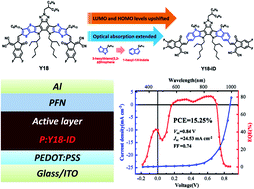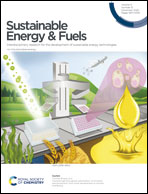Indole-based A–DA′D–A type acceptor-based organic solar cells achieve efficiency over 15 % with low energy loss†
Abstract
In order to increase the power conversion efficiency (PCE) of organic solar cells, developing high-performance non-fullerene small molecule acceptors is important for efficient charge generation and small energy loss. Herein, we design and synthesize a new member of the A–DA′D–A-series acceptor family, Y18-ID, which employs 1-hexyl-1H indole (ID) instead of the traditional 2-hexylthieno[3.2-b]thiophene as the electronic donor. Compared to Y18, Y18-ID exhibits extended optical absorption towards the longer wavelength region and an upshift in both the highest occupied molecular orbital and the lowest unoccupied molecular orbital energy levels. Organic solar cells based on P:Y18-ID delivered a power conversion efficiency of 15.25% with a very low energy loss of 0.51 eV. We believe that Y18-ID may become one of the most important candidates among non-fullerene acceptors, owing to its broader absorption profile and higher lowest unoccupied molecular orbital, which allow it to achieve both high open circuit voltage and short circuit current simultaneously.



 Please wait while we load your content...
Please wait while we load your content...